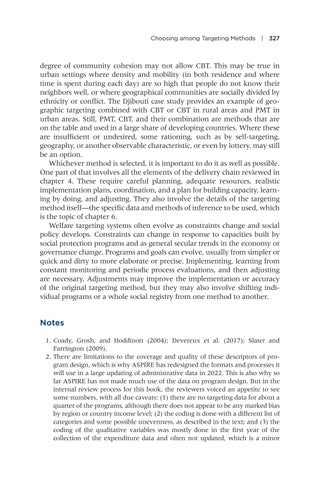Choosing among Targeting Methods | 327
degree of community cohesion may not allow CBT. This may be true in urban settings where density and mobility (in both residence and where time is spent during each day) are so high that people do not know their neighbors well, or where geographical communities are socially divided by ethnicity or conflict. The Djibouti case study provides an example of geographic targeting combined with CBT or CBT in rural areas and PMT in urban areas. Still, PMT, CBT, and their combination are methods that are on the table and used in a large share of developing countries. Where these are insufficient or undesired, some rationing, such as by self-targeting, geography, or another observable characteristic, or even by lottery, may still be an option. Whichever method is selected, it is important to do it as well as possible. One part of that involves all the elements of the delivery chain reviewed in chapter 4. These require careful planning, adequate resources, realistic implementation plans, coordination, and a plan for building capacity, learning by doing, and adjusting. They also involve the details of the targeting method itself—the specific data and methods of inference to be used, which is the topic of chapter 6. Welfare targeting systems often evolve as constraints change and social policy develops. Constraints can change in response to capacities built by social protection programs and as general secular trends in the economy or governance change. Programs and goals can evolve, usually from simpler or quick and dirty to more elaborate or precise. Implementing, learning from constant monitoring and periodic process evaluations, and then adjusting are necessary. Adjustments may improve the implementation or accuracy of the original targeting method, but they may also involve shifting individual programs or a whole social registry from one method to another.
Notes 1. Coady, Grosh, and Hoddinott (2004); Devereux et al. (2017); Slater and Farrington (2009). 2. There are limitations to the coverage and quality of these descriptors of program design, which is why ASPIRE has redesigned the formats and processes it will use in a large updating of administrative data in 2022. This is also why so far ASPIRE has not made much use of the data on program design. But in the internal review process for this book, the reviewers voiced an appetite to see some numbers, with all due caveats: (1) there are no targeting data for about a quarter of the programs, although there does not appear to be any marked bias by region or country income level; (2) the coding is done with a different list of categories and some possible unevenness, as described in the text; and (3) the coding of the qualitative variables was mostly done in the first year of the collection of the expenditure data and often not updated, which is a minor


